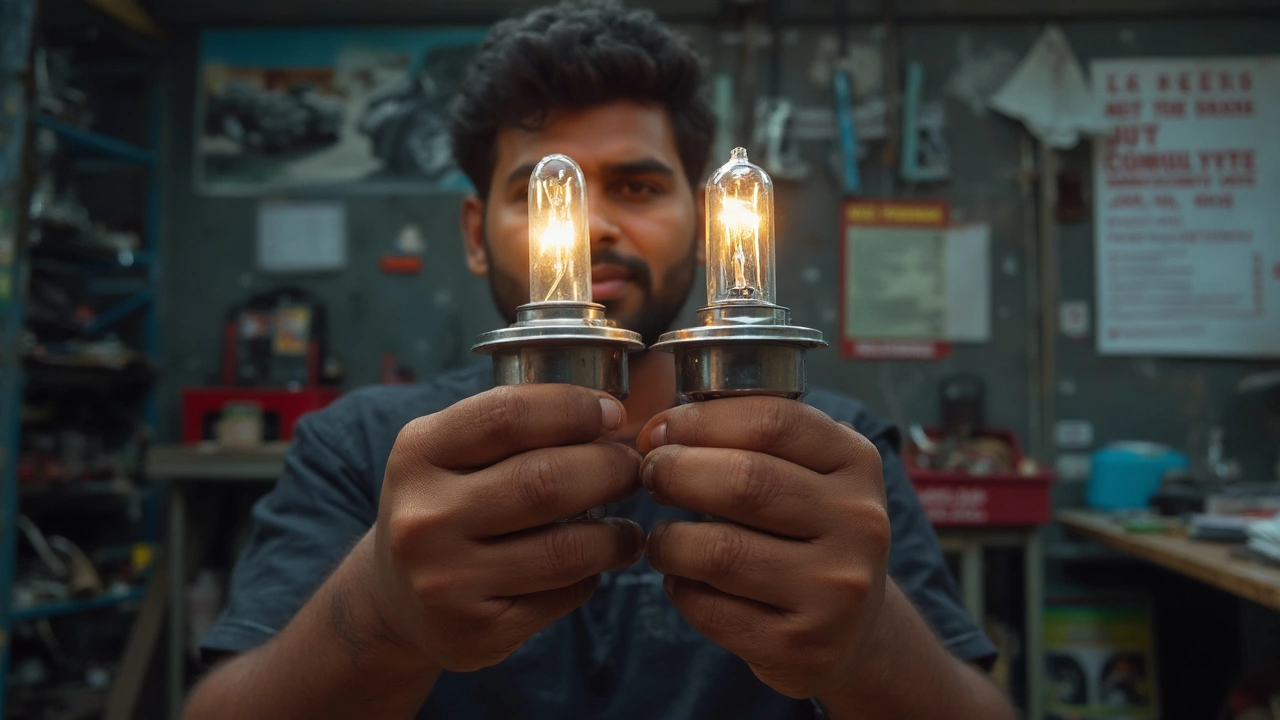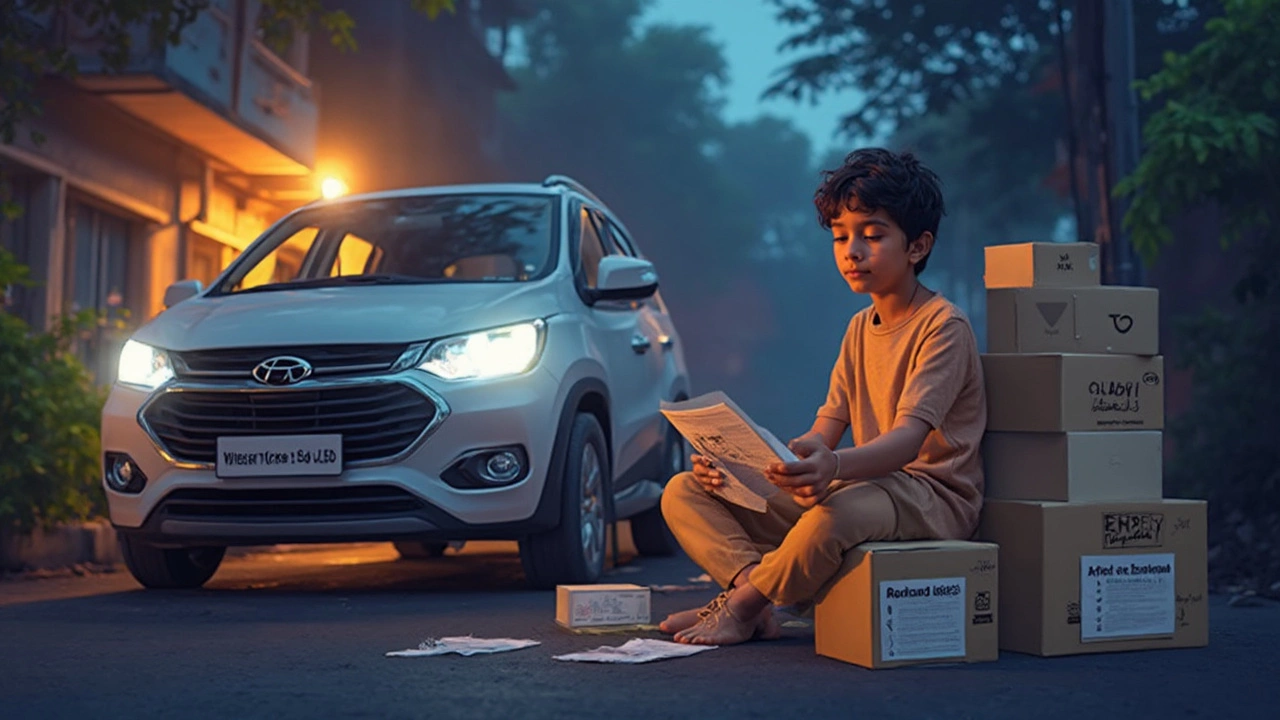Are LED Lights Better for Headlights? What You Need to Know
 Jun, 14 2025
Jun, 14 2025
On the road at night, the type of headlight you use actually matters a lot—think shorter reaction times, spotting hazards earlier, and saving money long-term. LED headlights have exploded in popularity, and it’s not just because they look modern.
These lights use way less power than old halogen bulbs, so you’re not putting as much strain on your car’s electrical system. That also means less heat, which is great since nobody wants burned wires or fried connectors. And unlike halogens that burn out after a year or two, a good pair of LEDs can last up to a decade.
If you’ve ever noticed newer cars with those crisp, white headlights that cut through the dark so much better than your dull yellowish beams, those are probably LEDs. The difference is pretty hard to ignore once you’ve seen both in action. You’ll get more visibility with less scatter—so you see farther down the road without blinding oncoming drivers (assuming your headlights are set up properly).
- How LED Headlights Really Work
- LEDs vs Halogens: A Side-by-Side Comparison
- Can You Just Swap LEDs Into Any Car?
- Staying Legal and Safe with LED Headlights
- Tips for Choosing and Installing LEDs
How LED Headlights Really Work
Most folks know LEDs are supposed to be brighter and last longer, but what actually makes them different from those old halogen bulbs? Here’s the simple breakdown: LEDs—short for Light Emitting Diodes—use a small chip that creates light when electricity moves through it. No glowing filament like halogens, so there’s less energy wasted as heat.
Because LEDs don’t get crazy hot, they’re more efficient and your headlight housing isn't stressed by constant heat cycles. Car makers jumped on this tech fast because it’s not just better for drivers—it’s easier on the car’s whole electrical setup, too. A lot of modern cars even use built-in sensors and mini cooling fans on the LED bulbs to avoid overheating, ensuring those chips keep working for years.
Here’s something a lot of people miss: the shape and direction of LED light is much more precise. The chips can be arranged inside the headlight to focus the beam exactly where you need it. That means crisper cut-off lines, less wasted light, and way fewer issues with blinding oncoming traffic (if your headlights are aimed right, of course).
Take a look at how they really stack up:
| Feature | LED Headlights | Halogen Headlights |
|---|---|---|
| Average Lifespan | 15,000-30,000 hours | 500-2,000 hours |
| Energy Use | 15-40 Watts | 55-65 Watts |
| Light Color | 5000-6500K (bright white) | 3200K (yellowish) |
| Warm-Up Time | Instant | 1-3 seconds |
If all you care about is having more usable light ahead, LEDs have the edge. But the way they’re made and the tech under the hood also brings those extra benefits like power savings and a much longer life. That's why a ton of folks are searching for LED headlights as an upgrade option.
LEDs vs Halogens: A Side-by-Side Comparison
If you’ve ever swapped out a busted headlight, you already know there’s a world of difference between LEDs and old-school halogens. Let’s break down what matters most: brightness, efficiency, cost, and ease of use.
- Brightness: Halogen bulbs usually put out 1,000 to 1,500 lumens, while most LED headlights easily reach 3,000 to 4,000 lumens. That means LEDs can literally double your nighttime visibility, especially on dark country roads.
- Color Temperature: Halogens make a yellow-ish light, usually around 3,200 Kelvin. LEDs? They put out a crisp white light between 5,000–6,500 Kelvin—way closer to daylight. You see more, and things look sharper.
- Lifespan: Halogen bulbs last about 500 to 1,000 hours. LEDs hold up for 20,000+ hours. So, while you’ll be replacing halogens every couple of years, a set of LEDs could outlast your car.
- Energy Use: LEDs use about 18–25 watts per bulb, but halogens typically suck up 55–65 watts. Less power draw means better battery health and maybe even a smidge more fuel efficiency.
- Cost: Halogen bulbs are cheap (you can grab them for $10–$20 each), while LEDs run $40–$100 or more per pair. But because LEDs last so much longer, you pay less in the long haul.
| Feature | Halogen Bulbs | LED Headlights |
|---|---|---|
| Brightness (Lumens) | 1,000–1,500 | 3,000–4,000 |
| Color Temp (Kelvin) | ~3,200K | 5,000–6,500K |
| Lifespan (Hours) | 500–1,000 | 20,000+ |
| Power Use (Watts) | 55–65 | 18–25 |
| Average Cost (per bulb) | $10–$20 | $40–$100 (pair) |
The real-world difference? With LED headlights, you not only see better, but you’ll spend less time buying and swapping bulbs. Still, consider the price up front and whether your car’s setup can handle the change before you buy.

Can You Just Swap LEDs Into Any Car?
So, you’re thinking of upgrading your headlights to LEDs? It sounds easy—pull out the old bulbs and pop in the new ones. The reality is, it’s a little more complicated than that for most cars, especially if your ride wasn’t built for LEDs in the first place.
First off, you have to check what type of headlight housing your car uses. Halogen reflector housings, which are super common, don’t always play nice with LED bulbs. Swapping in LEDs can lead to weird beam patterns or glare that annoys other drivers. Projector housings usually handle LEDs better, but even then, not all LED kits fit or perform equally.
Here’s a quick look at some common issues folks run into when doing a simple swap:
- LED headlights in old halogen housings often don’t put the light where it’s supposed to go.
- You might get dash warnings or flickering because LEDs use less power and your car thinks there’s a bulb out.
- Some vehicles require extra hardware—like CANbus adapters or resistors—just so the lights work right.
- Physical space can be a problem; some LED bulbs have cooling fans or big heatsinks that don’t fit inside tight headlight housings.
To help you figure out if your car is LED-friendly, check out this quick breakdown:
| Headlight Type | Direct LED Swap Possible? | Extra Parts/Steps Needed |
|---|---|---|
| Halogen Reflector | Rarely works well | May need housing upgrade or adjustment |
| Halogen Projector | Better compatibility | Possible CANbus/resistor fixes |
| Factory LED | Already optimized | Just replace with the right LED bulb |
| Xenon (HID) | Needs full housing retrofit | Not a simple bulb swap |
Here’s how to boost your odds of success:
- Double-check your vehicle’s manual for bulb type and compatibility.
- Buy quality LED kits from brands with real reviews—not just flashy ads.
- If possible, pick LED headlights designed specifically for your car’s make and model.
- Be ready to adjust headlight aim after installation, since new bulbs often change where the light lands.
Bottom line: Not every car is a plug-and-play candidate for LEDs. Do your homework, and you’ll avoid a lot of headaches. Plus, you’ll keep everyone safer on the road.
Staying Legal and Safe with LED Headlights
If you're thinking about dropping LED headlights into your ride, you’ve got to be more careful than you'd think. Not every LED bulb is legal, and using the wrong one can land you a ticket or—worse—make nighttime driving dangerous for you and everyone else. Every country and even different states have their own headlight rules, so double check before you buy.
In the US, headlights have to meet Federal Motor Vehicle Safety Standard 108. Plenty of those cheap LED kits online don’t actually get certified for road use. Just because they fit in your car doesn’t mean they’re allowed on the highway. Look for bulbs that actually say SAE or DOT approved right on the box or on the manufacturer's website.
Then there’s the blinding issue. Super bright LEDs might help you see, but if they’re not aimed correctly, they throw too much light into oncoming traffic. That’s one reason why many factory LEDs work way better than DIY kits—car makers optimize the reflector and lens for those exact bulbs. Swapping halogens for LEDs in a housing not made for them can scatter light everywhere. The result? Angry drivers flashing their high beams at you.
Want to stay safe and avoid fines? Try these simple steps:
- Only get LED bulbs that are specifically made as replacements for your vehicle and marked "DOT" or "E-mark" (for Europe).
- After installing, park about 25 feet from a wall and switch on your headlights. The beam should cut off cleanly below window height—if not, adjust the aim until it does.
- Don’t go overboard with wattage. Anything way brighter than your old bulbs is usually a red flag and might not be legal.
- If your car uses a headlight bulb warning system, make sure the LED kit is "CANbus compatible." If not, you'll get annoying dashboard warnings or flickering lights.
When in doubt, ask a local car shop or check your state’s DMV website. It’s way better to take 10 extra minutes now than have your headlights fail inspection or accidentally blind someone coming the other way.

Tips for Choosing and Installing LEDs
Ready to replace those old headlight bulbs? It's not as simple as grabbing any pack of LEDs and swapping them in. Here’s what you need to know if you want your car to benefit from upgrading to LED headlights without running into problems.
- Check compatibility first. Not every LED will fit your car. Headlight bulb sizes (like H11, 9005, or H7) need to match exactly. Car makers usually have this info in the owner’s manual or on the old bulb.
- Mind the heat. Even though LEDs run cooler than halogens, they still create heat at the base. Good kits use built-in fans or heat sinks so your new bulbs don’t overheat and fail early.
- Pay attention to lumens. Don’t just chase the highest number. Around 2,000–4,000 lumens per bulb gives you great visibility without blinding everyone else.
- Plug-and-play doesn’t always mean hassle-free. Sometimes older cars need extra wiring (like CANbus adapters) to stop flickering or dashboard errors. It’s usually clear in the product info if you’ll need this.
- Beam pattern matters. A bad pattern means scattered light and annoyed drivers flashing their brights at you. Stick with well-known brands that match your car’s reflector or projector housing.
Let’s lay out the practical numbers you’ll find on the package and what they really mean:
| Spec | What to Look For | Why It Matters |
|---|---|---|
| Lumens | 2,000-4,000 per bulb | Bright enough to see, but not so bright you blind others |
| Color Temperature | 5,000-6,500K | Gives you that clean white light without looking blue or purple |
| Wattage | 20-35W per bulb | Higher wattage might cause heat issues or not work with your wiring |
| Rated Lifespan | 30,000+ hours | Means fewer bulb changes and less hassle |
Got your kit? Here’s a quick step-by-step for installing LEDs:
- Unplug your old bulbs by disconnecting the wiring harness.
- Plug in the new LED—test it before locking everything back in place.
- Secure the LEDs in the housing just like the old ones. If your kit uses a fan or heat sink, make sure nothing blocks airflow.
- If you notice flickering or error lights, add a decoder or resistor (most LED sets show which cars need these).
- Check your beam pattern. Adjust aim if it’s lighting up the trees or blinding drivers.
Do a quick test after dark before your first drive, just to be sure you’re lighting up the road—not blinding everyone in your path.